Aside from freshwater fish, cats are the most common household pets in the United States. Current research suggests there are around 90 million domestic cats and another 60 to 100 million feral cats nationwide. Domestic cats typically make great pets and are often purchased by homeowners to reduce mice and rodent populations in and around their homes.
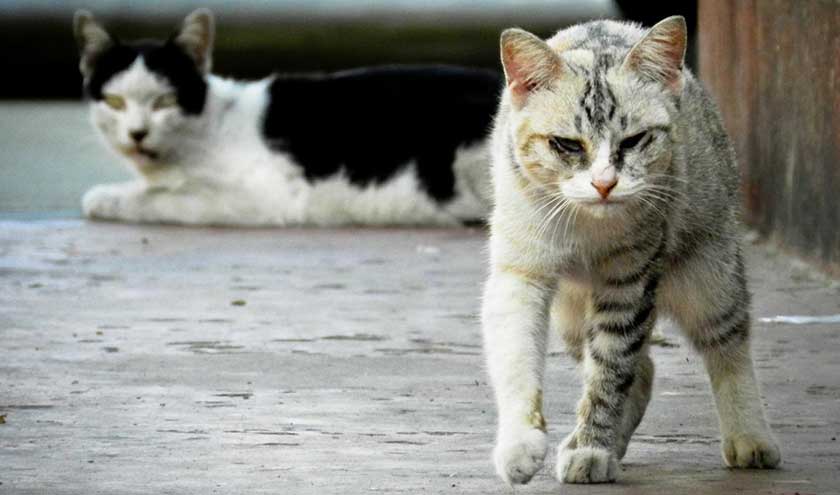
Feral cats, or cats that have abandoned their owners and are living in the wild, however, are a common nuisance for homeowners, especially those living in urban areas. Along with being a potential carrier for diseases and illnesses like rabies, ringworm, toxoplasmosis, distemper, and many others, feral cats have a negative effect on local wildlife populations.
Feral cats are known to raid the nests of small animals like songbirds, rabbits, and other small mammals. According to a study on the effects of cats on local wildlife, cats kill over a billion birds each year and are in part responsible for the decline in songbird populations. Cats are also known to pillage garbage, damage gardens, and urinate on pretty much everything in order to urine mark territory. Don’t worry though, in this guide we will show you what we think are the best cat repellents and how to get rid of cats for good!
What You Need to Know About Cats Before You Take Action
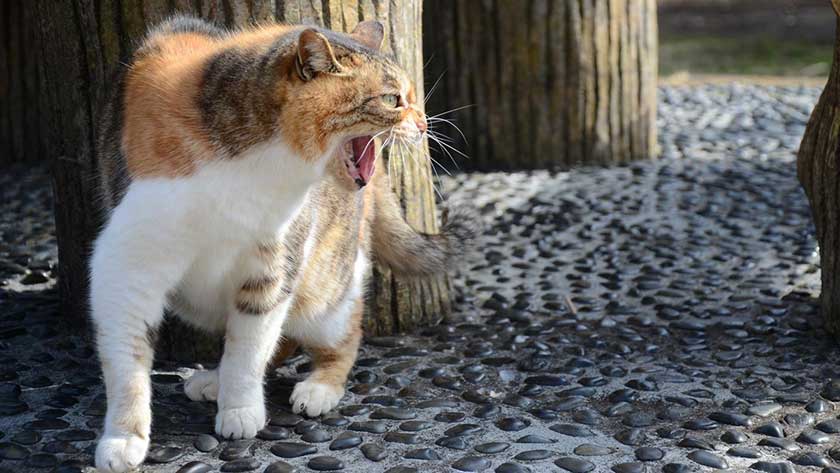
It’s important to note that cats are personal property if they can be identified with a collar or other form of identification. Cats without identification are considered feral cats, but that doesn’t’ mean you can legally use lethal control methods without consequences. it is always best to refer to local laws if you do intend to use lethal control methods. Also, keep in mind that just because a cat doesn’t have a collar or other form of identification, that doesn’t mean it’s not someone’s pet. For this reason, we almost always recommend using cat repellents and other natural control techniques.
First, make your yard or garden an unfavorable place for the cats to live by removing food sources and sealing entry points into shelters. Then, I recommending using Critter Ridder repellent spray. You can use it alone or in conjunction with the motion-activated repellent spray listed below near problem areas like trash cans or gardens. If that does not solve your problem, I recommend using live traps to trap and relocate the cats or utilizing the TNR method described below. Around gardens, use chicken wire fencing along with natural citrus oils and peels to deter cats from frequenting these areas.
The paragraph above summarizes what I would do, but all the products on this list can be very effective.
Here Are the Best Ways to Get Rid of Cats
1. Critter Ridder Cat Spray (Spray Directly on Problem Areas)
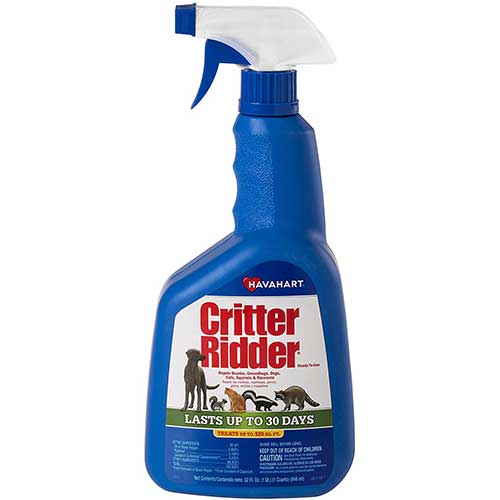
Critter Ridder is one of our favorite organic cat repellent sprays. Cats are irritated by and do not like the smell or taste of pepper, which is why Havahart includes black pepper, piperine, and capsaicin into their spray. If you haven’t heard of capsaicin, don’t worry, it is a safe red pepper compound that is EPA registered and USDA approved, making it compliant for organic gardening.
While critter ridder is advertised to repel additional pests, including skunks, dogs, cats, squirrels, raccoons, and other animals, we find it most effective at repelling cats, skunks, and raccoons If you read reviews of critter ridder, most of the negative reviews will by from people who used it for squirrels or chipmunks.
Below is a video of a man sharing his experience using Critter Ridder.
Critter Ridder can be found in both liquid and granular forms. In most cases, the spray works better because they give off a stronger odor. The only time I recommend using the granular form if you expect the temperature to drop below 40 degrees Fahrenheit or you live in an area with frequent rain.
Havahart advertises that one application protects up to 320 square feet and provides 30 days of protection. In our experience, however, it is best applied at least once per work for maximum effectiveness.
You can spray the formula directly on trash cans, plans, garbage cans, bird feeders, and other problem areas.
2. PetSafe Motion Activated Cat Repellers (Place Near High Traffic Areas)
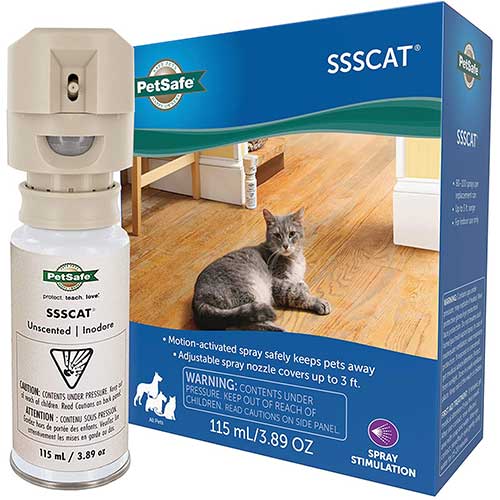
PetSafe Motion Activated Repellent is a great product that sprays an unscented spray that surprises cats and scares them from coming back. While this is a good repellent for large areas, it is great to keep cats away from certain areas like trash cans or gardens. Many homeowners actually buy this product to keep domestic cats off furniture, counters, beds, and other areas.
It has an adjustable spray nozzle that has a range of about 3 feet. With each can, you can expect between 80-100 sprays. It is environmentally friendly and unlike some aerosols, it is complete Ozone friendly.
They say a picture is worth 1000 words and a video is worth a million, so here is a video of this product in action.
Important note: the product does require 4 AA batteries to operate.
3. Fencing and Chicken Wire (Use to Block Cat Access)
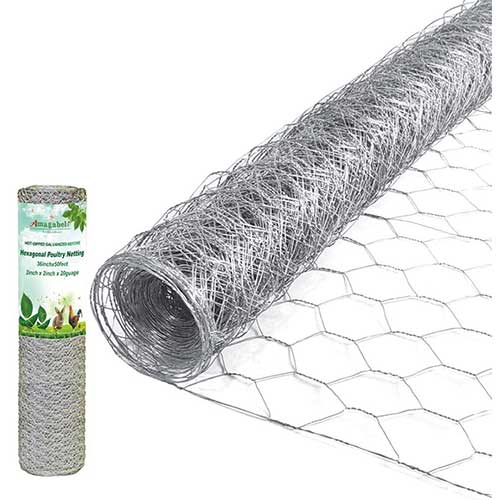
Chick wire is a great multi-purpose tool to get rid of cats. One thing that makes chicken wire-like this hexagonal Galvanized Chicken Wire so effective is that cats hate the feeling of chicken wire on their paws. This makes it so they typically will not even attempt to climb it. Also, because they hate the feeling of it, you can use it to cover areas they frequently dig. You can even use it to cover recently planted seeds in gardens. To make the chicken wireless visible, you sprinkle some soil on top of the chicken wire so it is not so visible. When the cats begin to dig they will immediately feel the mesh and stop digging.
Chicken wire fences don’t need to be very high to effectively deter cats. Typically, cats won’t even attempt to climb over the fence unless they have a strong motive to do so.
4. Live Cat Trap (Relocate or Utilize The TNR Method)
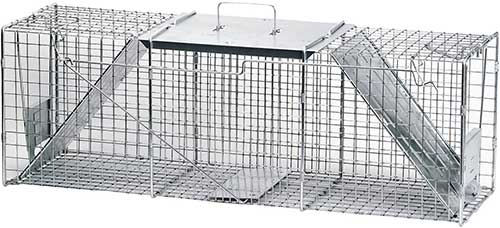
This Havahart Large 1 Door Live Trap One of the most surefire ways to get rid of stray cats. Once captured, the cats can be relocated to another area or taken to an animal control agency. When using live traps, you want to make sure the trap is large enough to accommodate a full-size cat.
Some animal rescue and care organizations will have TNR programs (trap, neuter, release) that have been shown to be effective in some cases.
Pro tip: When placing traps, the best place to set them is near feeding areas or where cats are most frequently seen. Also, keep in mind that feral cats are considered wild animals, and while it is unlikely, they may try to scratch you from inside the trap.
The second trapping technique in this video is closest to what we recommend. A simple cage trap with some food located in the rear of the trap is a very simple way to catch cats.
Related Article: 12 Best Ways to Get Rid of Racoons
5. Predator Guard Repeller (Scares Cats Away)
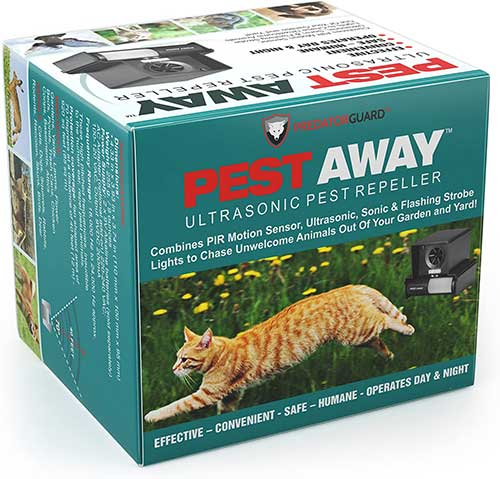
The video below shows the Predator Guard Repeller being used to scare cats away. You can skip to 4:40 in the video to see it in action. I was surprised to see this even worked for deer, raccoons, turkey, squirrels, dogs, and other animals.
6. DIY Natural Cat Repellent Spray – Lemon Spray
When it comes to natural repellents, you’ll hear a lot of mixed reviews when it comes to lemon oil. The truth is that most cats do not like the smell of lemon oil. The reason most people find it ineffective is that they are using a product that does not have a high enough concentration. I actually included a video within the next product review on this list that shows cats reacting to pure lemon oil.
Some homeowners and gardeners find that orange and lemon peels can deter cats in small areas like gardens. Here is the simplest spray formula. The spray solution consists of ⅓ Lemon Juice, ⅓ alcohol, and ⅓ water. Here is a video showing how to make it.
7. NOW Lemon Oil is Effective In Isolated Areas

As discussed above, cats are repulsed by the smell of lemon oil. While the man in the video below is using lemon oil on surfaces inside his one to prevent his cat from scratching, NOW lemon oil can be effective outside as well. The natural scent of lemon oil does not have as large of an effective area as the critter ridder spray above, it is still very effective.
8. Company of Animals Hisser
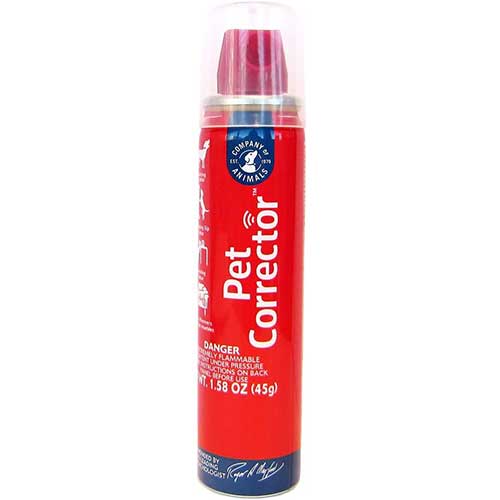
This is actually a product I haven’t personally test, but in theory, it should work. I realized this after reading many reviews on the Company of Animals Pet Corrector. One of the most common complaints by those who use this on dogs is that it also “scare the crap out of their cats.”
This product is actually designed to stop dogs from misbehaving. It works by emitting a hissing sound through a quick burst of compressed air that mimics the warning hiss of a snake. While this certainly isn’t the most surefire way to get rid of cats on this list, it will likely make them leave your property very quickly.
The Company of Animals says this is effective for most animals including cats, horses, and more. So, as an added bonus, you may be able to use this product to train a dog or other problematic animals around your home.
9. Natural Cat Prevention Methods
Eliminate the Cats Habitat
If you have a shed or other abandoned building near your residence, seal up entry points. The cat may be using
Remove Bird Feeders
Cats aren’t attracted to the seeds in the feeder itself. Instead, they’re attracted to the feeding birds that are unaware they’re being hunted.
Eliminate the Cats food Source
One common reason cats frequent areas is in search of food. If you have brush piles, junk piles, abandoned cars, or other items in your yard that small rodents could be living in or under, cats are likely using this area as a hunting ground. The brush and cover give cats a great advantage over unexpecting prey.
Another obvious food source for cats is pet food for other domestic animals like dogs or other cats. When feeding pets, do so inside until cats are no longer frequenting where you live.
10. Wash and Clean Scent Markings
If you have stray cats frequenting your property, you likely already know they like to urinate on everything. They do this to mark “their territory” and often return to the same areas they have marked.
Washing and cleaning urine marks reduce the likelihood that cats will return to the same area.
11. Local Organizations Relocate Cats
Due to the sheer number of stray cats, many townships and communities have organizations that will relocate stray cats to a park or living area.
Important Considerations of Cat Behavior
Cat Litter Size: Mature female cats with an adequate can produce three litters of kitten per year. Cats can offspring during any more of the year and typical litter sizes range between 2-12 kittens.
Cat Activity: Feral and stray cats are typically most active during the nighttime hours, however, depending on this season and available food sources this can change. Cats, like other felines, will hide and rest in a den or lair. It’s very common for stray cats to inhabit and live under, abandoned buildings, porches, crawl spaces, and other areas that offer them adequate protection.
Cat Diet: Feral cats have a similar diet as house cats. They hunt small rodents, birds, amphibians, and reptiles. They also eat a variety of fruits and vegetables. Stray cats are more likely to scavenge for scraps of food in garbage cans, in buildings, and around buildings when preferred food sources are not available.
Cat Habitat: Feral cats are usually found in urban areas and tend to gravitate towards alleys, lots that have been abandoned, and backyards. They rely on small mammals and rodents living near human dwellings as a source of food.
They are often mistaken by as house cats, and unfortunately, are often fed by humans. This type of behavior only incentivizes the cats to stick around the area. Cats do not burrow or create dens. Instead, they search for a suitable area that provides some degree of security like a crawlspace, drainage pipe, space under a porch, or abandoned building.
Frequently Asked Questions (FAQ)
Do Cat Repeller Sprays Actually Work?
Repellent sprays can be effective, but be aware many sprays on the market simply do not work. Sprays work best in small and isolated areas. They’re typically not a practical or cost-effective solution for very large open areas and fields.
That said, sprays can be effective when sprayed around target areas like garbage cans, gardens, cars, areas the cats frequently urine mark, and entry points onto your property. Due to their simplicity, we do recommend using sprays as the first line of defense.
If sprays do not work, we recommend exploring other options like live traps, chicken wire fencing, and repellers that scare cats away (I will include my favorites below).
Pro tip: To maximize the effectiveness of repellents, ensure there are as few attractants as possible. Cats, almost like humans, will not enter an area unless it seems favorable to them. If they see your property as an unfavorable place to be, they will simply leave.
Is Having Stray Cats on My Property Dangerous?
Stray cats can be dangerous and cause property damage in some cases. Unlike domestic cats, feral cats often do hot have medical shots and treatments that protect them from certain illnesses and diseases.
For this reason, feral cats are more likely to be carriers for infectious diseases, fleas, parasites, and other illnesses. If they scratch you or your pet, this could lead to a life-threatening illness.
Feral cats often cause property damage and can attract additional pests. They often get into unsecured trash cash cans and spread garbage around your property.
How Can I Keep Cats Out of My Garden?
One common complaint from gardeners is that stray cats love to use their garden as a litter box. Cats also love to dig in gardens, which can damage plants. Fencing and chicken wire is the most effective way to keep cats out of your garden.
Another technique that is someone effective is at preventing cats from digging under plants in your garden is taking trimmings, sicks, or small branches from around your garden and punching them into the soil around plants. Point them slightly out so that they act almost like a spike as the cat comes near the plant. This will make it difficult for the cat to get close enough to dig under it. Once the plant gets large enough, you can remove the trimmings or sticks.
Related Article: 7 Best Ways to Get Rid of Moles
How Can I Tell if a Cat is Feral?
There are no biological differences between domestic and stray cats, however, feral cats often have a more unkempt appearance. The word feral means the cat has either escaped his owner or was born without contact with humans.
Feral cats fur often have a scruffy look and their bodies of often very lean and lanky. Both domesticated and feral cats are around 9-10 pounds on average when fully mature, although certain breeds can grow significantly larger.
Feral cats also tend to travel in groups called colonies.
Why Do More Cats Keep Showing Up?
There are several reasons that more and more cats may be frequenting your property. The most common reason is that a food source or favorable living area is present on your property.
Also, keep in mind that feral cats reproduce quickly. Feral cats are not neutered, so overpopulation of cats can occur very quickly. After removing cats, it can create an opportunity for new cats to move in and claim this new territory.
What Diseases do Feral Cats Carry?
Feral cats can carry a number of diseases including rabies, ringworm, scabies, toxoplasmosis, distemper, zoonotic, feline leukemia, feline aids, and many others.
Feral cats can also carry small insects and pests on them like fleas and ticks that can cause many additional problems.
What is the difference between a stray cat and a feral cat?
A stray cat is one that has been socialized to people at some point in their life, but has left heir home, and has lost contact and dependence on humans.
Feral cats are cats that have never had contact with humans or have had little contact with humans that has reduced over time
Do Ultrasonic Repellers Work for Cats?
There are mixed reviews and opinions among the pest control community whether or not ultrasonic repellers alone can effectively repel pests. They also seem to be more effective for some animals than others. I do recommend two repellers on this list for cats, but I personally think the strobe light and spray functions built into the products are more effective than the frequency emissions.
In my opinion, although many reviews claim ultrasonic repellers are effective, I have not found enough convincing evidence to recommend them as a stand-alone solution. In fact, the FTC actually cracked down on ultrasonic pest repeller products marking campaigns in 2003 because there was no credible scientific evidence that they actually worked. The technology has advanced since then, but after testing ultrasonic repellers on a number of pests, I have not been impressed by the results.
Related Article: Do Ultrasonic Pest Repellers Work
Should I Call an Exterminator to Get Rid of Cats?
In most cases, professional intervention is not needed to get rid of stray cats. If DIY seems to be ineffective, we do recommend contacting a nearby pest control company for advice and a quote for professional treatment. Local exterminators will likely use a spray or granule in conjunction with live traps.
Does Cayenne Pepper Repel Cats?
Although cayenne pepper does repel cats, it is often not a strong enough repellent to keep cats away on its own. For best results, combine it with other natural repellents like black pepper. The first product on this list is a great formula to keep cats away.
Final Thoughts About Cats
The best way to get rid of cats in yards and gardens varies depending on a number of conditions. But, that’s a really boring answer so I’ll try to give something a little more helpful below.
Here is my advice
By utilizing one of the above control methods, or several methods used together, it is often possible to repel cats without contacting a professional control service. That said, feral cats can carry diseases and be a serious menace for homeowners. If natural remedies and trapping methods remain ineffective, I do recommend contacting a professional service.
Let me know if you have any questions below, I would be happy to answer them. Also, let me know if you have tried any of the control methods listed above. If you do decide to try any of these methods, please come back to this page and share with other readers what worked and what didn’t.
Related Article: How to Get Rid of Groundhogs
My name is Blane and I’m a life-long resident of Southeastern Louisiana. I’ve been working as Pest Control Technician and Inspector for about 1.5 years now.
I’ve worked in many other industries as well, including consulting, managing, as well as at the ground level in fields including Food Service, Corporate Automotive sales, and finance. Whether it be providing counsel, content, or hands-on support; my goal remains to add value to the lives of the people I serve.
If you have any questions regarding pest control, leave them below. I would be happy to help you out in any way I can.
